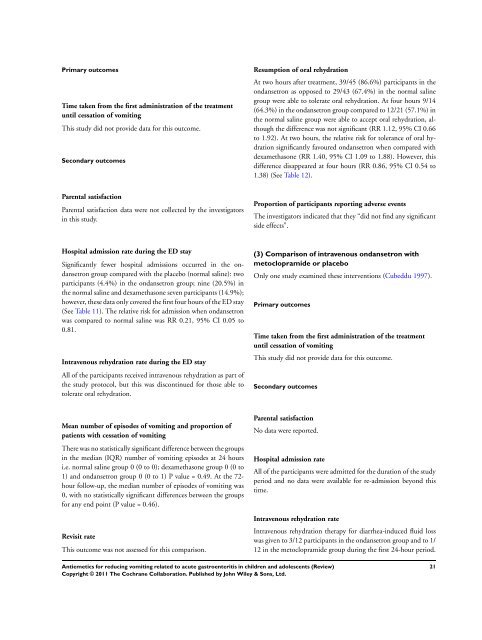Antiemetics for reducing vomiting related to acute ... - Update Software
Antiemetics for reducing vomiting related to acute ... - Update Software
Antiemetics for reducing vomiting related to acute ... - Update Software
You also want an ePaper? Increase the reach of your titles
YUMPU automatically turns print PDFs into web optimized ePapers that Google loves.
Primary outcomes<br />
Time taken from the first administration of the treatment<br />
until cessation of <strong>vomiting</strong><br />
This study did not provide data <strong>for</strong> this outcome.<br />
Secondary outcomes<br />
Parental satisfaction<br />
Parental satisfaction data were not collected by the investiga<strong>to</strong>rs<br />
in this study.<br />
Hospital admission rate during the ED stay<br />
Significantly fewer hospital admissions occurred in the ondansetron<br />
group compared with the placebo (normal saline): two<br />
participants (4.4%) in the ondansetron group; nine (20.5%) in<br />
the normal saline and dexamethasone seven participants (14.9%);<br />
however, these data only covered the first four hours of the ED stay<br />
(See Table 11). The relative risk <strong>for</strong> admission when ondansetron<br />
was compared <strong>to</strong> normal saline was RR 0.21, 95% CI 0.05 <strong>to</strong><br />
0.81.<br />
Intravenous rehydration rate during the ED stay<br />
All of the participants received intravenous rehydration as part of<br />
the study pro<strong>to</strong>col, but this was discontinued <strong>for</strong> those able <strong>to</strong><br />
<strong>to</strong>lerate oral rehydration.<br />
Mean number of episodes of <strong>vomiting</strong> and proportion of<br />
patients with cessation of <strong>vomiting</strong><br />
There was no statistically significant difference between the groups<br />
in the median (IQR) number of <strong>vomiting</strong> episodes at 24 hours<br />
i.e. normal saline group 0 (0 <strong>to</strong> 0); dexamethasone group 0 (0 <strong>to</strong><br />
1) and ondansetron group 0 (0 <strong>to</strong> 1) P value = 0.49. At the 72hour<br />
follow-up, the median number of episodes of <strong>vomiting</strong> was<br />
0, with no statistically significant differences between the groups<br />
<strong>for</strong> any end point (P value = 0.46).<br />
Revisit rate<br />
This outcome was not assessed <strong>for</strong> this comparison.<br />
Resumption of oral rehydration<br />
At two hours after treatment, 39/45 (86.6%) participants in the<br />
ondansetron as opposed <strong>to</strong> 29/43 (67.4%) in the normal saline<br />
group were able <strong>to</strong> <strong>to</strong>lerate oral rehydration. At four hours 9/14<br />
(64.3%) in the ondansetron group compared <strong>to</strong> 12/21 (57.1%) in<br />
the normal saline group were able <strong>to</strong> accept oral rehydration, although<br />
the difference was not significant (RR 1.12, 95% CI 0.66<br />
<strong>to</strong> 1.92). At two hours, the relative risk <strong>for</strong> <strong>to</strong>lerance of oral hydration<br />
significantly favoured ondansetron when compared with<br />
dexamethasone (RR 1.40, 95% CI 1.09 <strong>to</strong> 1.88). However, this<br />
difference disappeared at four hours (RR 0.86, 95% CI 0.54 <strong>to</strong><br />
1.38) (See Table 12).<br />
Proportion of participants reporting adverse events<br />
The investiga<strong>to</strong>rs indicated that they “did not find any significant<br />
side effects”.<br />
(3) Comparison of intravenous ondansetron with<br />
me<strong>to</strong>clopramide or placebo<br />
Only one study examined these interventions (Cubeddu 1997).<br />
Primary outcomes<br />
Time taken from the first administration of the treatment<br />
until cessation of <strong>vomiting</strong><br />
This study did not provide data <strong>for</strong> this outcome.<br />
Secondary outcomes<br />
Parental satisfaction<br />
No data were reported.<br />
Hospital admission rate<br />
All of the participants were admitted <strong>for</strong> the duration of the study<br />
period and no data were available <strong>for</strong> re-admission beyond this<br />
time.<br />
Intravenous rehydration rate<br />
<strong>Antiemetics</strong> <strong>for</strong> <strong>reducing</strong> <strong>vomiting</strong> <strong>related</strong> <strong>to</strong> <strong>acute</strong> gastroenteritis in children and adolescents (Review)<br />
Copyright © 2011 The Cochrane Collaboration. Published by John Wiley & Sons, Ltd.<br />
Intravenous rehydration therapy <strong>for</strong> diarrhea-induced fluid loss<br />
was given <strong>to</strong> 3/12 participants in the ondansetron group and <strong>to</strong> 1/<br />
12 in the me<strong>to</strong>clopramide group during the first 24-hour period.<br />
21












